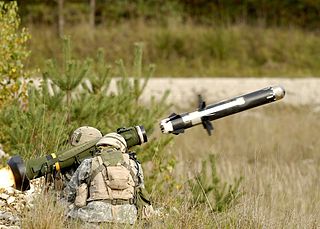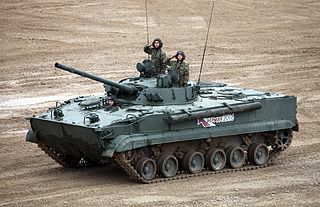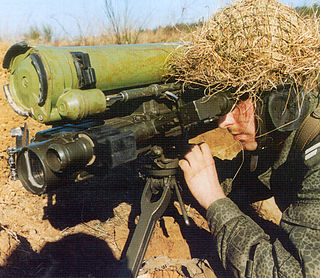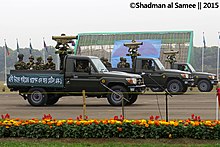
An anti-tank guided missile (ATGM), anti-tank missile, anti-tank guided weapon (ATGW) or anti-armor guided weapon is a guided missile primarily designed to hit and destroy heavily armored military vehicles. ATGMs range in size from shoulder-launched weapons, which can be transported by a single soldier, to larger tripod-mounted weapons, which require a squad or team to transport and fire, to vehicle and aircraft mounted missile systems.

The BMP-3 is a Soviet and Russian infantry fighting vehicle, successor to the BMP-1 and BMP-2. The abbreviation BMP stands for Boevaya Mashina Pekhoty.

The 9M133 Kornet is a Russian man-portable anti-tank guided missile (ATGM) intended for use against main battle tanks. It was first introduced into service with the Russian army in 1998.

Missile d'Infanterie Léger Antichar or MILAN is a Franco-West German anti-tank guided missile system. Design of the MILAN began in 1962; it was ready for trials in 1971, and accepted for service in 1972. It is a wire-guided semi-automatic command to line of sight (SACLOS) missile, which means the sight of the launch unit must be aimed at a target to guide the missile. The MILAN can be equipped with a MIRA or MILIS thermal sight to give it night-firing ability.

The BGM-71 TOW is an American anti-tank missile. TOW replaced much smaller missiles like the SS.10 and ENTAC, offering roughly twice the effective range, a more powerful warhead, and a greatly improved semi-automatic command to line of sight (SACLOS) that could also be equipped with infrared cameras for night time use.

The RPG-29 "Vampir" is a Soviet reusable rocket-propelled grenade (RPG) launcher. Adopted by the Soviet Army in 1989, it was the last RPG to be adopted by the Soviet military before the fall of the Soviet Union in 1991.

The Buk is a family of self-propelled, medium-range surface-to-air missile systems developed by the Soviet Union and its successor state, the Russian Federation, and designed to counter cruise missiles, smart bombs, fixed- and rotary-wing aircraft, and unmanned aerial vehicles. In the Russian A2AD network, Buk is located between the S-200/300/400 systems above and the point defense Tor and Pantsir type systems below.

The HJ-8 or Hongjian-8 is a second generation tube-launched, optically tracked, wire-guided anti-tank missile system which was originally deployed by the People's Liberation Army since the late 1980s.

The 9M113 Konkurs is a Soviet SACLOS wire-guided anti-tank missile.

The 9K115 Metis is a man-portable, tube launched, SACLOS wire-guided anti-tank guided missile of the Soviet Union. It is considered the Soviet counterpart to the American M47 Dragon ATGM.

Trophy is a military armored vehicle active protection system (APS) designed by Rafael Advanced Defense Systems.

The Raad or RAAD is an Iranian wire-guided anti-tank guided missile based on the Soviet 9M14M Malyutka missile. The Raad began mass production in 1988 and was publicly unveiled in 1997. It is manufactured by Parchin Missile Industries, a subsidiary of Iran's Defense Industries Organization.

Hezbollah, is a Lebanese Shia Islamist political party and militant group, has an exceptionally strong military wing, thought to be stronger than the Lebanese Army, and equivalent to the armed strength of a medium-sized army. A hybrid force, the group maintains "robust conventional and unconventional military capabilities", and is generally considered to be the most powerful non-state actor in the world.

The Toophan is an Iranian SACLOS anti-tank guided missile reverse-engineered from the American BGM-71 TOW missile. The Toophan 1, an unlicensed copy of the BGM-71A TOW missile, began mass production in 1988 and the Toophan 2, a BGM-71C ITOW variant, was publicly shown in 2000.

JSC Konstruktorskoe Buro Priborostroeniya (KBP) is one of the main enterprises in the field of Russian defense industry, based in Tula. It is engaged in designing high-precision weapon systems for the Army, the VMF and the VKS, as well as anti-air defense systems, high-rate-of-fire cannons and small arms, in addition to civilian products. Its full name goes as "Joint-Stock Company Instrument Design Bureau named after Academic A. G. Shipunov". Its shareholders include High Precision Systems, part of the State Corporation Rostec.

Kornet-D is a Russian anti-tank missile carrier based on the GAZ-2975 4x4 high mobility vehicle. It employs 9M133M Kornet-EM missiles in both tandem-HEAT or thermobaric warhead variants.
The Sarab Active Protection System (Mirage) is an active protection system, developed by the Syrian Scientific Studies and Research Center (CERS) and designed to help the Syrian Army’s T-55, T-62, and T-72 tanks counter line of sight anti-tank guided missiles (ATGMs).

The 9M133M Kornet-M Russian anti-tank guided missile (ATGM) is an improved version of the 9M133 Kornet ATGM, with increased range and an improved warhead.





















